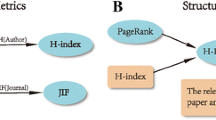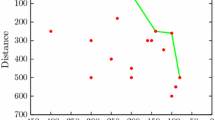Abstract
Selecting an appropriate set of scientific journals which best meets the users' needs and the dynamics of science requires usage of weight parameters by which journals can be ranked. Previous methods are based on the simple counting of relevant articles, or hits in SDI runs. The new method proposed combines hit numbers in SDI runs and journals' impact factors to a weight parameter called Selective Impact. The experimental results obtained show that ranking by Selective Impact leads to a higher quality of the conclusions to be drawn from journal rank distributions.
Similar content being viewed by others
References
E. GARFIELD,Citation Indexing: Its Theory and Application in Science, Technology, and Humanities, John Wiley & Sons, New York, 1979.
D. de SOLLA PRICE, The Citation Cycle. In: B. C. GRIFFITH, Ed.,Key Papers in Information Science: White Plains, Knowledge Industry Publications, New York, 1980, 195–210.
S. C. BRADFORD,Documentation, Crosby Lockwood London, 1948.
A. T. MICEVIČ,Methodologische Grundlagen der Untersuchung wissenschaftlich-technischer Informationsströme, VEB Bibliographisches Institut, Leipzig, 1979. (Transl. from Russian).
They are not considered here. See the instructive list of references in: A. SCHUBERT, W. GLÄNZEL, A Dynamic Look at a Class of Skew Distributions: A Model with Scientometric Applications,Scientometrics 6 (1984) No. 3, 166–167.
M. BONITZ, Eine Methode zur Optimierung des Zeitschriftenbestandes in großen Forschungsbibliotheken, in:Schriftenreihe Dokumentation/Information des Instituts für Informationswissenschaft, Erfindungswesen und Recht, Heft 31, Ilmenau, 1975, 25–40.
U. WELLHAUSEN, A. PFUND, Ein Programmsystem zur Analysc von Informationsströmen. in:ZfI-Mitteilungen No. 78, Leipzig, 1983. 114–130.
M. BONITZ, P. SCHMIDT. The Growing Importance of R&D Reports as Shown by Nuclear Science Reports,Int. Forum Inf. Doc. 3 (1978) No. 1, 8–12. Reprinted in: J.Radional. Chem. 57 (1980) No. 1, 7–16.
M. BONITZ, P. SCHMIDT, Koinzidenzmethode und Zwei-Ebenen-Konzept,Informatik 28 (1981) No. 4, 36–41.
E. GARFIELD Ed.,SCI Journal Citation Reports — A Bibliometric Analysis of Science Journals in the ISI Data Base. Institute for Scientific Information, Philadelphia, 1980.
E. GARFIELD, The Mystery of the Transposed Journals List — wherein Bradford's Law of Scattering is Generalized According to Garfield's Law of Concentration,Current Contents (1971) No. 31, 5–6.
M. BONITZ, Evidence for the Invalidity of the Bradford Law for the Single Scientist,Scientometrics 2 (1980) No. 3, 203–214.
Author information
Authors and Affiliations
Rights and permissions
About this article
Cite this article
Bonitz, M. Journal ranking by selective impact. New method based on SDI results and journal impact factors. Scientometrics 7, 471–485 (1985). https://doi.org/10.1007/BF02017162
Received:
Issue Date:
DOI: https://doi.org/10.1007/BF02017162




